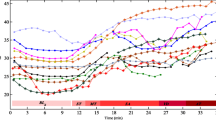Abstract
The heart rate variability (HRV) can be taken as an indicator of the coordination of the cardio-respiratory rhythms. Bispectral analysis using a direct (fast Fourier transform based) and time-invariant approach has shown the occurrence of a quadratic phase coupling (QPC) between a low-frequency (LF: 0.1 Hz) and a high-frequency (HF: 0.4–0.6 Hz) component of the HRV during quiet sleep in healthy neonates. The low-frequency component corresponds to the Mayer–Traube–Hering waves in blood pressure and the high-frequency component to the respiratory sinus arrhythmia (RSA). Time-variant, parametric estimation of the bispectrum provides the possibility of quantifying QPC in the time course. Therefore, the aim of this work was a parametric, time-variant bispectral analysis of the neonatal HRV in the same neonates used in the direct, time-invariant approach. For the first time rhythms in the time course of QPC between the HF component and the LF component could be shown in the neonatal HRV.






Similar content being viewed by others
References
Arnold M, Witte H, Schelenz C (2002) Time-variant investigation of quadratic phase couplings caused by amplitude modulation in electroencephalic burst-suppression patterns. J Clin Monit Comput 17:115–123
Chen S, Cowan CFN, Grant PM (1991) Orthogonal least-squares learning algorithm for radial basis function networks. IEEE Trans Neural Netw 2:302–309
Dykes FD, Ahmann PA, Baldzer K, Carrigan TA, Kitney R, Giddens DP (1986) Breath amplitude modulation of heart rate variability in normal full term neonates. Pediatr Res 20:301–308
Leonard JA, Kramer MA, Ungar LH (1992) Using radial basis functions to approximate a function and its error-bounds. IEEE Trans Neural Netw 3:624–626
Mhaskar HN (1996) Neural networks for optimal approximation of smooth and analytic functions. Neural Comput 8:164–177
Nikias L, Petropulu AP (1993) Higher-order spectra analysis: a nonlinear signal processing framework. Prentice-Hall, NJ
Park J, Sandberg IW (1993) Approximation and radial-basis-function networks. Neural Comput 5:305–316
Powell JD (1987) Radial basis functions for multivariable interpolation: a review. In: Cox MG (ed) Algorithms for approximation. Clarendon Press, Oxford
Saul JP (1991) Cardiorepiratory variability: fractals, white noise, nonlinear oscillators, and linear modeling. What’s to be learned? In: Haken H, Koeppchen HP (eds) Rhythms in physiological systems. Springer, Berlin Heidelberg New York, pp 115–126
Schlögl A (2000) The electroencephalogram and the adaptive autoregressive model: theory and applications. Shaker, Aachen
Schwab K, Putsche P, Eiselt M, Helbig M, Witte H (2004) On the rhythmicity of quadratic phase coupling in the trace alternant EEG in healthy neonates. Neurosci Lett 369:179–182
Schwab K, Eiselt M, Schelenz C, Witte H (2005) Time-variant parametric estimation of transient quadratic phase couplings during electroencephalographic burst activity. Methods Inf Med 44:374–383
Swami A (1988) System identification using cumulants. USC–SIPI report, vol 140
Swami A, Mendel JM (1988) Adaptive cumulant-based estimation of ARMA parameters. American control conference, ACC-88. Atlanta, GA
Witte H, Schack B, Helbig M, Putsche P, Schelenz C, Schmidt K, Specht M (2000) Quantification of transient quadratic phase couplings within EEG burst patterns in sedated patients during electroencephalic burst-suppression period. J Physiol Paris 94:427–434
Witte H, Putsche P, Eiselt M, Arnold M, Schmidt K, Schack B (2001) Technique for the quantification of transient quadratic phase couplings between heart rate components. Biomed Tech 46:42–49
Witte H, Putsche P, Schwab K, Eiselt M, Helbig M, Suesse T (2004) On the spatio-temporal organisation of quadratic phase-couplings in ‘trace alternant’ EEG pattern in full-term newborns. Clin Neurophysiol 115:2308–2315
Acknowledgment
This study was supported by the Deutsche Forschungsgemeinschaft (DFG, Wi 1166/2-3 and 2-4).
Author information
Authors and Affiliations
Corresponding author
Rights and permissions
About this article
Cite this article
Schwab, K., Eiselt, M., Putsche, P. et al. Time-variant parametric estimation of transient quadratic phase couplings between heart rate components in healthy neonates. Med Bio Eng Comput 44, 1077–1083 (2006). https://doi.org/10.1007/s11517-006-0120-7
Received:
Accepted:
Published:
Issue Date:
DOI: https://doi.org/10.1007/s11517-006-0120-7




